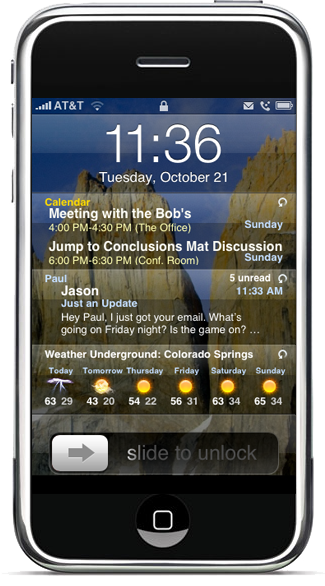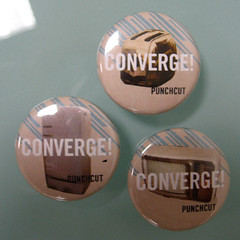Let’s just go ahead and get the Apple items out of the way…
// iPhone 3G speed issues
If your ‘twice as fast’ iPhone 3G isn’t - you’re not alone. No official word from Apple yet, but a number of interesting theories out there. Wired has a pretty good rundown of the prevailing notions, including an interactive map showing upload and download speeds at different locations.
// More Mobile Video Streaming
Mobile video streaming company Flixwagon has released an app similar to Qik for 3G iPhone, but only for jailbroken devices. Here’s hoping Apple eventually opens the door for more applications like this that access currently verboten parts of the iPhone functionality - clearly developers feel there’s a demand but that’s not to say they are abandoning iPhone app development for Android….
// Android Issues
On the contrary, it appears developers increasingly favor Apple’s devices, due to flaws with Android. Apparent favoritism on Google’s part coupled with new competition from the open-sourcing of Symbian have certainly contributed to developers’ doubts about Android, but we’re not convinced this will result in much of a shift in developer priorities. We expect to see multiple players in this field for a while yet. And with clear suggestions T-Mobile will launch an Android device this year, it’s definitely too soon to write any Android epitaphs.
The rest of the news…
// iKitchen?
Miele’s showing a kitchen concept with a touchscreen on one side and a stovetop on the other. Looks intriguing but you definitely want to remember which side of the range you’re on. Take a look at this hypermodern design (and a bonus image of what looks like a phone being cooked).
// Braille Camera Concept
Unfortunately it’s just a concept for now, but this camera with 3D braille display is a really interesting idea. Not only that, but the associated research mentioned (around displays for the blind and how the blind judge distance) provides some fascinating hints at how perception and cognition may differ for those who cannot rely on sight.
// More Non-Food Uses for Corn
Samsung has introduced an ‘eco-friendly’ phone whose case is entirely made of bioplastic, and Nokia has also announced plans for ‘green’ phones as well. Another Samsung device reportedly notifies the user when it is fully charged to avoid wasting extra electricity. Clearly we still need to develop environmentally friendly materials that don’t impact the world food supply so dramatically, but this is still a step in the right direction.
// New Intel PCs Wake Up for Phone Calls
Intel just announced new PCs that can wake up from a sleep state to receive internet phone calls. Current PCs have to be fully on (thus drawing more power) in order to receive these calls. This removes a significant obstacle to computers as a viable phone communication medium.
// Fingerprint Biometrics Come to Mobile
Atrua Technologies just announced a partnership with Lenovo to bring to market the first commercial mobile phone with fingerprint technology built in. This extends a technology already used in laptops to the mobile space, but this solution uses less power, memory and processing power.
// Microsoft Provides More Information About the Sphere
Microsoft has provided a new movie of their Sphere concept, providing a bit more perspective about what the interface will do. While it’s an interesting new form for interaction, it’s not yet tied to any application so compelling it has to be made. As several commenters have pointed out, this device may get more interesting when combined with other technologies, like eye-tracking (providing full 3D for one viewer) or holographic imagery within a more transparent dome. So far - just not exciting enough for prime time.
Add this to digg, del.icio.us, etc.


 It’s fitting that the name of this blog is in reference to this very idea — that users would benefit from at-a-glance information at the idle screen that doesn’t require interaction. The iPhone’s default UI makes no real attempt at putting the idle screen to use.
It’s fitting that the name of this blog is in reference to this very idea — that users would benefit from at-a-glance information at the idle screen that doesn’t require interaction. The iPhone’s default UI makes no real attempt at putting the idle screen to use. Convergence is sometimes viewed as the consolidation of multiple technologies towards a singular über-device. I prefer to view convergence as the tendency of technologies, as they grow in complexity and scope, to overlap and consolidate functions. Convergence is a trend wherein devices and functions take on commonly shared traits, but this doesn’t mean that this trend ultimately ends with a single, multi-functional mega-device, no matter how cool and ‘mad scientist’ that might sound. Product mobility, technical innovation, component obsolescence, and proprietary ownership of certain functions are among the many forces that will ensure we continue to interact with ecosystems of related and overlapping devices rather than a single device with every function built in.
Convergence is sometimes viewed as the consolidation of multiple technologies towards a singular über-device. I prefer to view convergence as the tendency of technologies, as they grow in complexity and scope, to overlap and consolidate functions. Convergence is a trend wherein devices and functions take on commonly shared traits, but this doesn’t mean that this trend ultimately ends with a single, multi-functional mega-device, no matter how cool and ‘mad scientist’ that might sound. Product mobility, technical innovation, component obsolescence, and proprietary ownership of certain functions are among the many forces that will ensure we continue to interact with ecosystems of related and overlapping devices rather than a single device with every function built in.